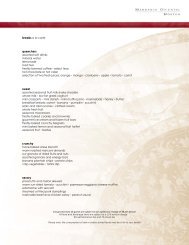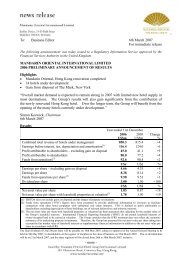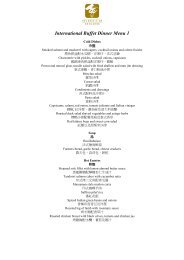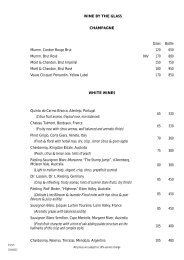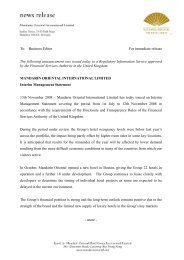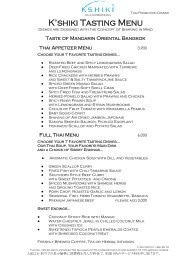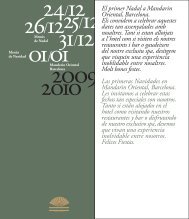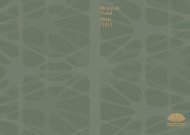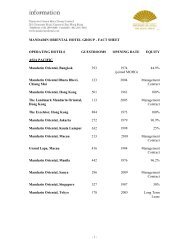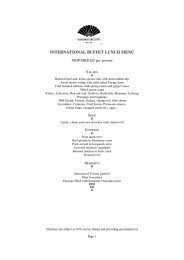Annual Report 2011 - Mandarin Oriental Hotel Group
Annual Report 2011 - Mandarin Oriental Hotel Group
Annual Report 2011 - Mandarin Oriental Hotel Group
You also want an ePaper? Increase the reach of your titles
YUMPU automatically turns print PDFs into web optimized ePapers that Google loves.
42 <strong>Mandarin</strong> <strong>Oriental</strong> International Limited<br />
Financial Risk Management<br />
A Financial risk factors<br />
The <strong>Group</strong>’s activities expose it to a variety of financial risks: market risk (including foreign exchange risk and<br />
interest rate risk), credit risk and liquidity risk.<br />
The <strong>Group</strong>’s treasury function co-ordinates, under the directions of the Board of <strong>Mandarin</strong> <strong>Oriental</strong> <strong>Hotel</strong> <strong>Group</strong><br />
International Limited, financial risk management policies and their implementation. The <strong>Group</strong>’s treasury policies<br />
are designed to manage the financial impact of fluctuations in interest rates and foreign exchange rates and to<br />
minimize the <strong>Group</strong>’s financial risks. The <strong>Group</strong> uses derivative financial instruments, principally interest rate swaps<br />
and caps, and forward foreign exchange contracts as appropriate for hedging transactions and managing the <strong>Group</strong>’s<br />
assets and liabilities in accordance with the <strong>Group</strong>’s financial risk management policies. Financial derivative contracts<br />
are executed between third party banks and the <strong>Group</strong> entity that is directly exposed to the risk being hedged.<br />
Certain derivative transactions, while providing effective economic hedges under the <strong>Group</strong>’s risk management<br />
policies, do not qualify for hedge accounting under the specific rules in IAS 39. Changes in the fair value of any<br />
derivative instruments that do not qualify for hedge accounting under IAS 39 are recognized immediately in profit<br />
and loss. It is the <strong>Group</strong>’s policy not to enter into derivative transactions for speculative purposes. The notional<br />
amounts and fair values of derivative financial instruments at 31st December <strong>2011</strong> are disclosed in note 25.<br />
i) Market risk<br />
Foreign exchange risk<br />
Entities within the <strong>Group</strong> are exposed to foreign exchange risk from future commercial transactions, net<br />
investments in foreign operations and net monetary assets and liabilities that are denominated in a currency<br />
that is not the entity’s functional currency.<br />
<strong>Group</strong> entities are required to manage their foreign exchange risk against their functional currency. To manage<br />
their foreign exchange risk arising from future commercial transactions, entities in the <strong>Group</strong> use forward foreign<br />
exchange contracts and foreign currency options in a consistent manner to hedge firm and anticipated foreign<br />
exchange commitments.<br />
Currency risks as defined by IFRS 7 arise on account of monetary assets and liabilities being denominated<br />
in a currency that is not the functional currency. At 31st December <strong>2011</strong>, if the United States dollar had<br />
strengthened/weakened by 10% against Euro with all other variables unchanged, the <strong>Group</strong>’s profit after tax<br />
would have been US$0.1 million lower/higher (2010: US$0.5 million lower/higher), arising from foreign<br />
exchange losses/gains taken on translation. The amount attributable to the shareholders of the Company would<br />
be US$0.1 million (2010: US$0.5 million). This sensitivity analysis ignores any offsetting foreign exchange<br />
factors and has been determined assuming that the change in foreign exchange rates had occurred at the balance<br />
sheet date. The stated change represents management’s assessment of reasonably possible changes in foreign<br />
exchange rates over the period until the next annual balance sheet date. There are no other significant monetary<br />
balances held by <strong>Group</strong> companies at 31st December <strong>2011</strong> that are denominated in a non-functional currency.<br />
Differences resulting from the translation of financial statements into the <strong>Group</strong>’s presentation currency are not<br />
taken into consideration.<br />
Interest rate risk<br />
The <strong>Group</strong> is exposed to interest rate risk through the impact of rate changes on interest bearing liabilities<br />
and assets. These exposures are managed partly by using natural hedges that arise from offsetting interest rate<br />
sensitive assets and liabilities, and partly through the use of derivative financial instruments such as interest rate<br />
swaps, caps and collars. The <strong>Group</strong> monitors interest rate exposure on a monthly basis by currency and business<br />
unit, taking into consideration proposed financing and hedging arrangements. The <strong>Group</strong>’s guideline is to<br />
maintain 40% - 60% of its gross borrowings, in fixed rate instruments. At 31st December <strong>2011</strong> the <strong>Group</strong>’s<br />
interest rate hedge was 44% (2010: 45%), with an average tenor of 3.2 years (2010: 4.3 years). The interest rate<br />
profile of the <strong>Group</strong>’s borrowings after taking into account hedging transactions are set out in note 17.



